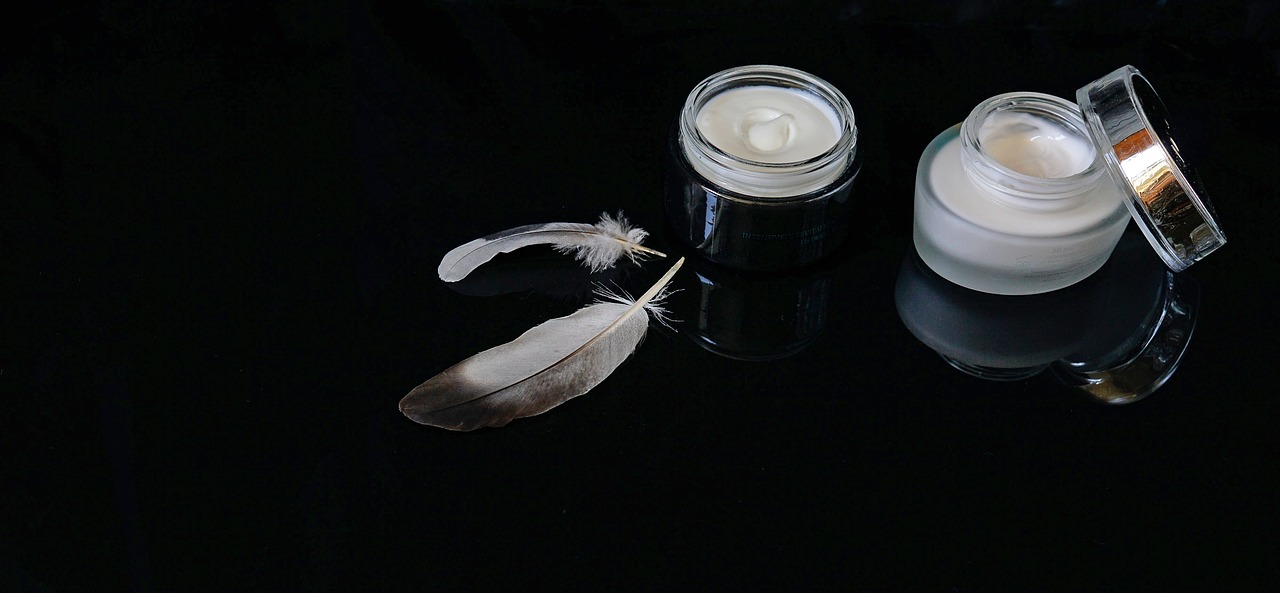Best Transmitters and Radio Synchronizers in 2020
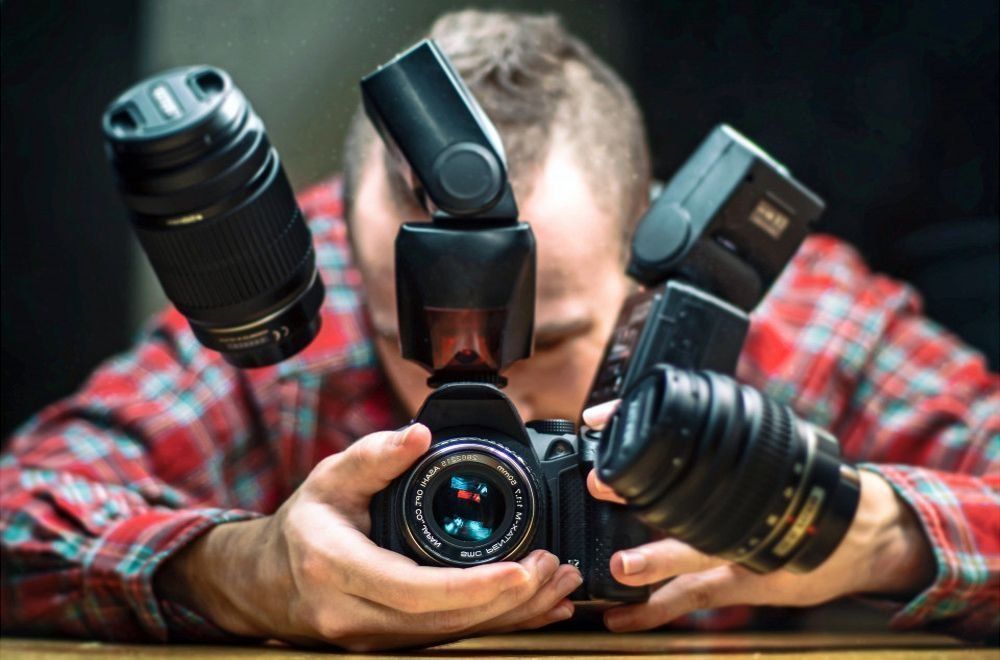
Those who are professionally involved in photography are well aware that often a camera flash alone is not enough to create a good photo. External flashes are constantly used to create the right lighting in studios or at various events. And here the question arises before the photographer: How to make an external flash fire correctly and at the right time? After all, all of them, with extremely rare exceptions, are equipped with light traps and are triggered almost by a lighter. This can be useful sometimes, but most of the time it gets in the way.
And this is where synchronizers come to the rescue. They can be made in the form of sync cords connected to an external flash using a wire, but they are a thing of the past due to their inconvenience.
Now they are being replaced by radio synchronizers, which transmit a trigger signal through a special transmitter. They consist of a transmitter, which is installed in a special connector on the camera, called a "hot shoe", and transmits a signal to trigger the receiver, which is placed on the flash and receives this signal.
They are much more convenient than sync cords, if only because people do not have to stumble over cords lying all over the floor, and you worry about whether there is enough cable to connect that distant flash.
In our article, we will explain what TTL, groups, channels are and why they are needed at all. We will tell you how to choose the right radio synchronizer for your purposes, consider popular models and help you make the right choice.
Parameters
For a beginner, out of habit, it may be difficult to understand the specific parameters characteristic of radio synchronizers, but here everything is not as complicated as it might seem at first glance.
- TTL is a very useful feature that allows an external flash to fire in exactly the same way as a camera flash. It transmits power parameters and other information automatically configured by the camera as if via a sync cord.
This will come in handy if you don't have time to manually adjust specific settings for each flash.
- Channels is a parameter indicating which channel the radio signal will be triggered by.
This is necessary so that your flash is triggered only by a radio signal and does not "ignite" from the neighboring one.
- Groups is a parameter showing how many flashes can be individually configured.
It allows you to control each of your flash, setting it the desired parameters. It is also possible to combine multiple flashes with common settings.
Synchronizers
And now let's go directly to the models on the market.
Cactus V4 (~ $ 40)
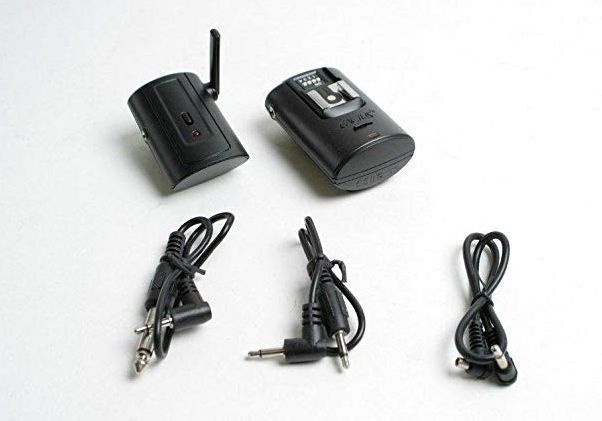
Let's start our review with an inexpensive and very popular model - Cactus V4.
Immediately I would like to note the good quality of the plastic, everything is assembled with dignity, the parts are tightly fitted to each other, nothing staggers or creaks. For this price, this is quite good.
The receiver is made in the form of a stand. It even has special feet on the battery compartment lid. Just above this compartment is a shoe for mounting in a standard flash shoe with a 1/4 '' hole, inside of which a thread is cut.There are no problems with installing the flash into this connector.
The transmitter fits comfortably into the camera's hot shoe and fits snugly into it.
Channel selectors are located on the back of the transmitter. There are only four of them, and changing the channel in which case it will not be difficult.
A special thank you should be said to the manufacturer for the fact that the Jack 3.5 mono connector is used for commutation in the receiver and transmitter, which connect with all cameras, there are wires for it in the kit, and, in general, these wires cost a penny.
The range of this model is 30 meters, and according to the results of numerous tests, it has no problems with activation in such a radius. And it doesn't matter where you put the equipment, on the street or in the apartment.
It should only be taken into account that its operating temperature is from -10 to 45 degrees, so it is better not to use it in severe frost.
The claimed sync speed is 1/500, but for most users it works at 1/350, which is also good, especially considering that most DSLR cameras have a minimum shutter speed of 1/250 for shutter sync.
Even during the tests, an interesting feature came to light: some flashes, in particular the Sigma 500 SU, can fire twice in one trigger start. The problem disappears if you turn the flash power to maximum, but with high-speed shooting at long exposure, you can get a double exposure, which is not good.
The synchronizer operates at 433 MHz, which can cause interference on some channels when working close to other photographers using similar synchronizers.
- Reliable actuation at the stated distance;
- Durability and workmanship;
- Convenient sync connector;
- Low price.
- Small flaws in ergonomics: the on indicator on the receiver is too recessed into the case, which is why you may not immediately see whether it is on or not;
- The receiver's battery cover is loose;
- The battery holder on the transmitter is not secure. It may be necessary to tighten the positive contact with a screwdriver.
Output:
This model is so popular with novice photographers for a reason. For a relatively low price, there are excellent characteristics that are not always found in more expensive models. Naturally, there is no need to talk about any TTL and other more complex automation, but it performs its functions as a synchronizer perfectly well.
It is perfect for strobe photographers and studio photography. This is probably one of the best value for money on the market.
Yongnuo 602RX (~ 1500-2500 rubles)
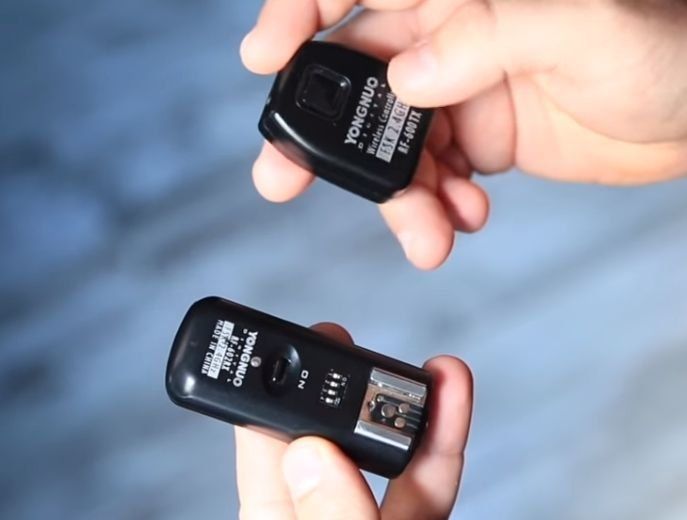
Another synchronizer from the budget segment on our list. This time from Yongnuo. A very simple model, which nevertheless proved its reliability more than once, working in completely different conditions. The functionality is small, but in principle, much is not required from the synchronizer.
The power button is located on both the transmitter and the receiver. Also on the receiver there are several channel position switches, if any of them will have interference.
The transmitter has a test button, with which you can check whether the synchronizer is working at all or wake up the flash from sleep mode.
If you need multiple synchronizers to work with multiple external flash units, you can simply purchase several additional receivers.
The range declared by the manufacturer is up to 100 meters. And they really do great at that distance.
In addition, the synchronizer can be used as a camera control panel. The wire from the receiver can be connected to a special connector on the camera and take pictures using the transmitter as a remote control.
The battery in the transmitter is very durable. It is enough for about a year of active use. The receiver uses conventional AA batteries. They are enough for a couple of months of active use, but if you use your equipment for several hours every day, you will have to change them even more often.
- Solid and reliable construction, resistant to different climatic conditions. You can shoot in the rain or snow. Places with high humidity, like caves, will not cause problems either;
- Good declared range. The device really works at 100 meters, as stated by the manufacturer;
- The camera control panel mode has been implemented, which allows you to activate the camera at a distance;
- Low price.
- Flimsy covers for the battery tray. What is on the receiver, what is on the transmitter, the covers dangle and strive to fly off after the first battery replacement;
- A rare and expensive transmitter battery. Due to its non-standard shape, the transmitter requires a special battery, which is rather problematic to find. And it costs 300 rubles.
Output:
This model is a good buy if you are looking for a reliable synchronizer that will honestly fulfill its flash control functions. This simple model is worth every penny spent on it and will serve you faithfully for a long time, and the dangling lids can simply be sealed with tape.
YOUNGNUO 622с (100-110 $)
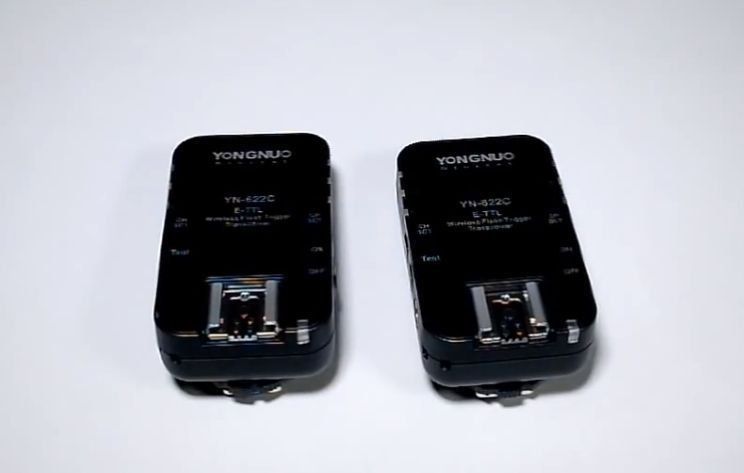
If you need more than just a flash igniter, Yongnuo has a lot to offer you.
If you have been photographing for a long time and are thinking of calling yourself a professional photographer, then you probably faced the problem of not being able to adjust the flash intensity. Therefore, I often had to run to the stands with a softbox or umbrella fixed on them, since it is often during photo shoots that I often have to change the flash settings. And if there are more than one racks, then these races begin to be very annoying, especially if the photo session is long
In the new Yongnuo model, you can adjust the flash settings on all modules by connecting one of them to the camera. This became possible due to the fact that each module is a so-called "transceiver".
It can simultaneously perform the functions of a receiver and a transmitter, so the same parameters that you set in the module on the camera will be used for flashes.
The functionality of the 622c is huge, especially when compared to the cheaper models.
In addition to the possibility described above to set the parameters manually from the camera, without approaching the flash, you can enable flash exposure compensation in automatic mode. Another important advantage of this synchronizer is the high-speed sync mode. It allows you to take photos at the fastest shutter speeds up to 1/8000 (!) Of a second.
Also, if you have a lot of flashes in your studio, you can split them into groups and adjust each group separately.
It even has an autofocus light function. It comes in handy if you are shooting in a dark room or outdoors at night. To check how the AF illuminator works, you can give a test pulse with the test button.
Since the transmitter is also a receiver, a flash can be installed in the transmitter thanks to the thru shoe system.
The range is short - only 50 meters, but this is enough for working in a studio or shooting outdoors.
The case of Yongnuo 622c is made of glossy plastic and scratches quickly.
- Huge functionality. This model implements a large set of all sorts of pleasant functions that greatly simplify the photographer's life;
- Autofocus illumination;
- More convenient battery format. It uses AA batteries. Exactly the same ones are used for flashes, so you don't have to buy other batteries for the synchronizer separately;
- The ability to work with groups of flashes;
- Work with group ratios is well implemented;
- Price.
- Glossy plastic scratches easily. Although the plastic is of high quality, and this does not greatly affect the performance of the device itself, it becomes worn out soon enough;
- Small radius of action;
- Unable to update firmware or connect external power supply.
Output:
This gadget will be a wonderful purchase for any professional photographer. Through the efforts of Yongnuo, you can get the same features as the expensive Poket Wizard for a much lower price.
PIXEL King Wireless TTL Flash Trigger Set (~ 90 $)
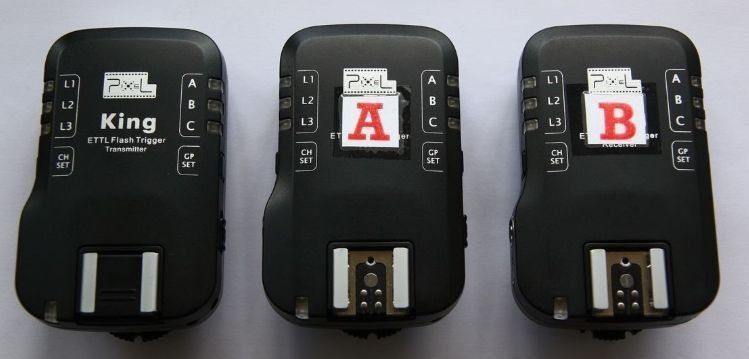
Another mid-range model that gives the photographer almost the same opportunity as the previous one. We will dwell on them in detail. It's worth starting with the appearance.
PIXEL King with all the rest of its goodness in the form of cables for studio flashes, USB - cables, stand, various straps and manuals, packed in an elegant case with a belt clip.
The gadget itself is made of matte plastic, does not scratch and looks more impressive than a device from Yongnuo. It can be seen that the design has been improved here.
PIXEL King is not a transceiver, its modules are a receiver and a transmitter. That, nevertheless, does not prevent him from implementing almost all the same functions that were used in Yongnuo 622c.
The only exception is the strobe mode, which is not even set in the transmitter settings.
An autofocus light is also present here, but works in a slightly different way. It looks like a pocket flashlight stain. Unlike Yongnuo 622c, the backlight of which looks like several lines placed in different planes.
But this is offset by the huge range of 150 meters, despite the declared 100. This opens up boundless horizons for shooting. Now you can even shoot with a long-range telephoto lens or place the flash out of line of sight.
For devices from PIXEL King there is a possibility of flashing. It is done via the included USB cable. An external power supply can be connected to the same connector.
- Build and design. Synchronizers from PIXEL King look beautiful and impressive, which sets them apart from competitors;
- Range of action. The range of 150 meters allows you to conduct any kind of shooting, which somehow depends on the distance;
- Possibility of flashing or connecting an external power supply;
- Good equipment;
- Affordable price.
- Strobe mode is not adjustable;
- There is no way to adjust the ratio of the groups.
Output:
It is worth giving preference to the PIXEL King if range is important to you when shooting. Otherwise, it is very similar to the Yongnuo 622c, so if the strobe settings are not important to you, then there is not much difference between these models. Well, one more plus in favor of PIXEL King is the presence of a USB connector.
PocketWizard
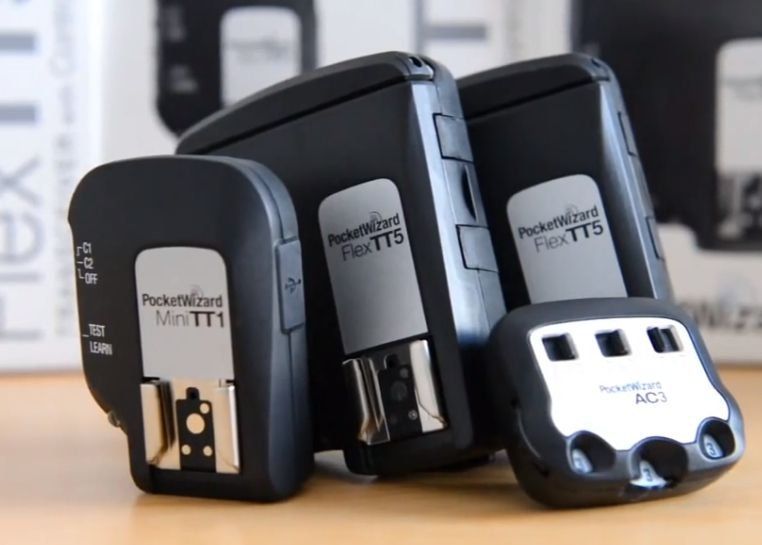
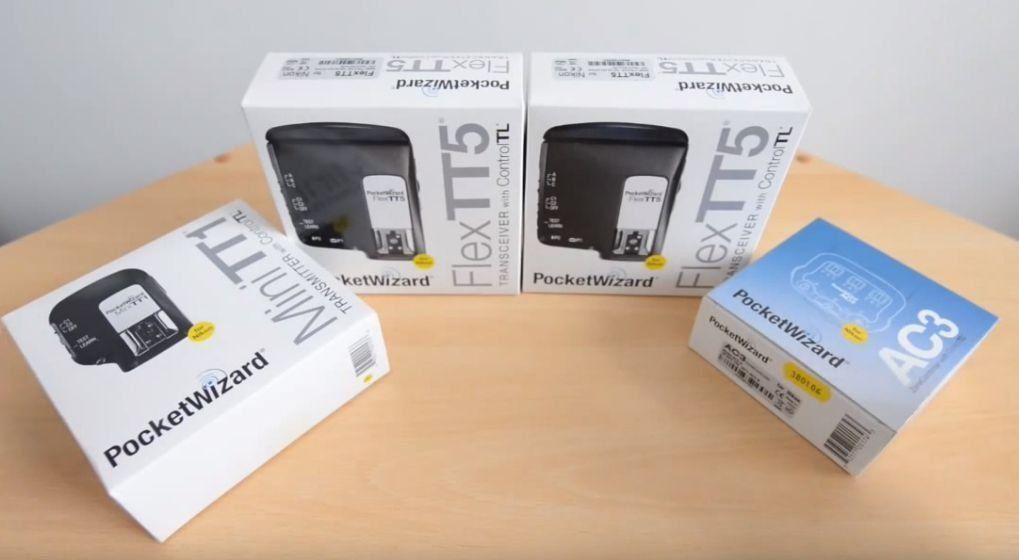
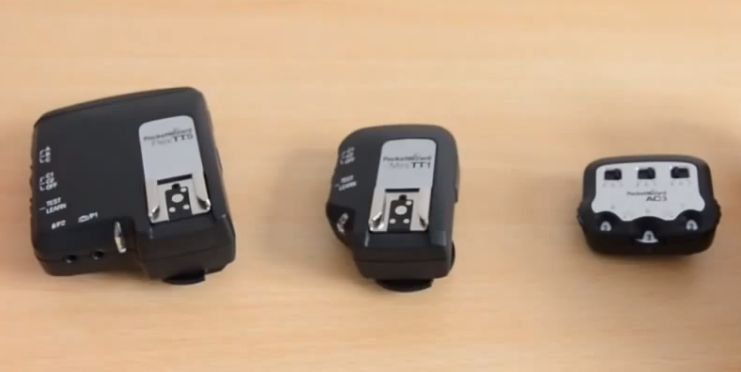
And finally, we will look at the most professional of the professional synchronizers - PocketWizard.
To begin with, unlike the rest of the devices discussed above, PocketWizard is a real system consisting of several modules, each of which performs its own function.
Modules
For example, we will consider 3 types of modules:
- PocketWizard FlexTT5 - transceivers can be both transmitters and receivers, respectively, can be installed on a camera or connected to a flash. In our example, they will act as receivers and stand on flashes;
- MiniTT1 is a transmitter. You can use FlexTT5 as a transmitter, but MiniTT1 is more convenient, weighs less and is more compact, although it only acts as a trigger for flashes;
- AC3 - control system. We will talk about it below.
Specifications
The PoketWizard features are truly impressive:
- The declared radius of action is 240 meters;
- As many as 35 channels are allocated for signal transmission;
- The ability to sync flashes even at a shutter speed of 1/8000 second;
- PoketWizard automatically synchronizes to the second (rear) curtain of the shutter mechanism, the settings are determined through the camera interface;
- PW modules can work with PLUS II and MultiMAX, albeit without TTL support.
After reviewing the parameters, it will not be superfluous to read the instructions. Indeed, in PocketWizard, the correct sequence of switching on / off the synchronizer modules, camera and flash units is very important, because if the sequence is confused, they simply will not turn on.
Also, before connecting the equipment, it is recommended to update the firmware to the latest version. It will not take much time and will help to avoid errors in the operation of the synchronizer software in the future.
It's not worth talking about the quality of plastic and assembly.Everything is assembled just great, the modules are pleasant to hold in your hands and it is a pleasure to work with them.
But how good they are, you can see only by testing them in practice. Everything works cleanly and smoothly, which is to be expected from PoketWizard.
Problems can only arise due to incorrectly selected adapters. Therefore, do not use conductors with special connectors intended for sync cords, as this may cause the system to work incorrectly.
The best option for attaching such equipment to a rack is an adapter from Lastolite or Poiskfoto.
Special attention should be paid to the AC3 ZoneController. This control station slides over the top of a transceiver or transmitter and allows individual control of each of the 3 preset flash groups.
Switches located closer to the user allow the flash to be switched to one of 3 available flash modes, which are indicated by intuitive icons.
- Automatic or TTL (A);
- Manual (M);
- Shutdown (crossed out zero).
On the front, with the help of special switches made in the form of small wheels, the power is set for each group of flashes.
With this device, you can set up the entire lighting scheme for a photo shoot in a few minutes, without touching the flashes once again.
This will be especially appreciated by those who have to put their flashes on high stands and climb them several times is very annoying.
- Unmatched build quality and materials. All parts are just perfectly matched to each other, each module feels like a single monolithic product;
- Huge range. None of the synchronization devices we've reviewed work at this range;
- Convenient modular system. Especially the AC3 ZoneController, which makes flash control as easy as possible;
- TTL mode. Although it is now available in much cheaper models, here it is implemented as well as nowhere else. You can rely on automation 100%. If you are a beginner photographer and do not know how to properly adjust the flash, rely on TTL.
- Impossibility to install something on top of the AC3 remote control / Usually this is not required, but for reportage photography it would be nice to also use on-camera shooting;
- Price. Alas, for such a miracle you will have to pay a rather large sum. An entire modular system can cost over $ 400;
Output:
Poket Wizzard remains the best professional synchronizer to date. If you plan to seriously engage in photography, he will be a great helper for you. Its price fully justifies itself. For this, albeit rather big money, you will receive quality that you will not find anywhere else.
new entries
Categories
Useful
Popular articles
-

Top rating of the best and inexpensive scooters up to 50 cubic meters in 2020
Views: 97661 -

Rating of the best materials for noise insulation for an apartment in 2020
Views: 95022 -

Rating of cheap analogues of expensive medicines for flu and colds for 2020
Views: 91751 -

The best men's running shoes in 2020
Views: 87680 -

Top ranking of the best smartwatches 2020 - price-quality
Views: 85091 -

Best Complex Vitamins in 2020
Views: 84801 -

The best dye for gray hair - 2020 top ranking
Views: 82406 -

Rating of the best wood paints for interior use in 2020
Views: 77202 -

Ranking of the best action cameras from China in 2020
Views: 75269 -

Rating of the best spinning reels in 2020
Views: 74827 -

The most effective calcium supplements for adults and children in 2020
Views: 72462 -

Top rating of the best in 2020 means for male potency with a description
Views: 68296
